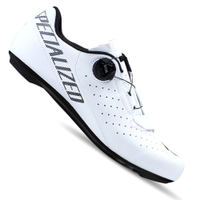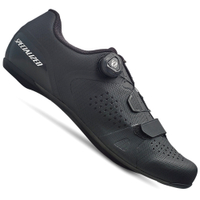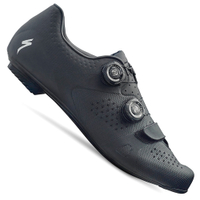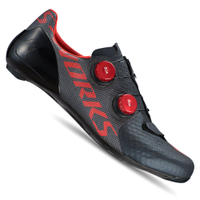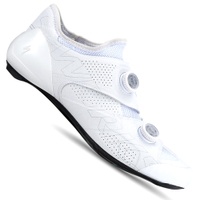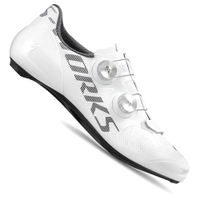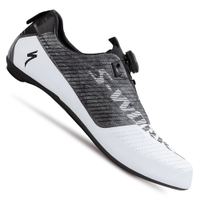Specialized road shoes: Which pair is right for you?
Helping you decipher the Specialized shoe range to find the right shoes for you
Since shoes and pedals are the main contact point for power transfer between you and the bike it’s worth spending some time to see what the key differences are between an entry-level shoe and the top of the range shoe on the market. We’re going to take a look at Specialized’s range of shoes, what you get as your investment increases and what benefits they can offer you as a rider.
Let's start at the beginning with Specialized’s Body Geometry ethos, founded over 20 years ago in the late '90s starting with Dr Roger Minkow, then bringing on board Dr Andy Pruitt and Dr Kyle Bickel. Specialized set out to create products for riders that riders would actually need based on their data and medical expertise. From the humble beginning of Minkow carving out saddle prototypes in his garage and Andy Pruitt’s expertise in footwear along with his research into arch support and foot position, Body Geometry has grown into of the most recognisable apparel and equipment brands in the world.
One thing you’ll notice if you follow professional cycling is the number of riders that choose Specialized shoes over a sponsor-correct shoe, you would think they must be doing something right if so many riders choose to opt for them over what is supplied by sponsors. But as a buyer, which shoe should you be looking at?
Looking at a range that starts at £99 for the Torch 1.0 and continues right up to the S-Works EXOS at £450, which shoe is right for you and what features are most import to you as a rider? Is it the lightest shoe, the stiffest shoe or the shoe with the most padding?
Torch
Launched in 2017 the Torch ranges of shoes consolidated Specialized’s offering below the S-Works range into an easier-to-understand format, the higher the number, the more features and performance-orientated the shoes become.
The Torch 1.0 shoes offer a Body Geometry sole and footbed designed and scientifically tested to boost power, increase efficiency, and reduce chance of injury by optimising hip, knee, and foot alignment. With an injection moulded nylon sole that is moderately stiff with about half the stiffness rating of the highest end performance shoes in the range. While this might not be what you are looking for if you are aiming to win a Tour de France sprint stage if you are less about performance and more about long days in the saddle touring these soles will help reduce vibration passed from the road to your feet. Paired with a perforated synthetic upper to help with ventilation, a Boa L6 dial and velcro strap for fit there is plenty of adjustment.
With the increase in price you gain Specialized’s medium stiffness carbon sole, rated at 7.0 compared to 6.0 of the Torch 1.0. Designed all about comfort, comfort and performance the Torch 2.0 has a mesh and TPU upper to allow more wiggle room in the toe box for a less constrictive fit. These also feature a single upgraded Boa IP1 dial which feature micro adjustment in both directions over the L6 featured on the 1.0 that micro adjusts to tighten but not to loosen.
These are reminiscent of the top of the line S-Works shoe from only a few years ago, and they sit at the top of the Torch line. These are the most performance orientated shoe within this range. As feature-packed as the top of the line shoe but at a more reasonable price, with the carbon FACT sole moving up another 1.5 points to 8.5. You start to look at some features that are more orientated to performance riders such as dual S2-SV Boas with dual direction adjustment for a micro-adjustable fit across more of the upper. A mix of TPU, mesh and synthetic materials are thermo bonded together in specific zones to create this upper that offers a fit and adjustability that can really be locked down while retaining support for all-day comfort.
S-Works shoes
Above the Torch range of shoes sits Specialized's range of S-Works shoes. Designed at the very cutting edge of cycling shoe construction, there are four S-Works-level shoes currently in the range.
Now you’re talking about the gold standard in performance shoes with WorldTour winning credentials to back it up. One of, if not the most popular single model of shoe amongst the pro peloton, you’ll see this shoe everywhere under professional riders. From the bottom up the shoe features an updated Fact Powerline sole, introduced with this model, boasting a stiffness of 15.0. While this may not be relevant when comparing brands, it is all relative if looking at other shoes within the range. The upper features another new material for Specialized with the use of Dyneema Mesh, an unstretchable fibre to create no stretch zones so you can really get a sock like fit with the upper. The Padlock heel is a reinforced plastic up that cups the whole of you heel to give unrivalled support and reduced heel lift. One noticeable improvement over the previous S-Works 6 is the level of padding on the tongue, with a plush thick tongue to make sure when you really crank them down they don’t crush your feet. The newest S3-Snap dials with an exclusive knurled aluminium dial mean you can even adjust the shoes through over shoes with gloves on.
The newest addition to the range features the same FACT Powerline sole as the S-Works 7 for a reassuringly stiff foundation, the upper is a complete reimagining of the cycling shoe. Featuring a full sock design reinforced with Dyneema with a wrap-around attachment system to reduce foot roll, lock in metatarsals and reduce pressure on the tendons in your foot. Heel support is taken care by the same Padlock heel as on the 7’s. Early reviews suggest that the shoe is very supporting even with the newest Boa Li2 fit system worn loosely and that it can be cranked right up with an even pressure if you really want that rock-solid connection to the bike. If you’re looking for a no-compromise race shoe within Specialized’s range you’ll most likely be choosing between the 7’s and the Ares.
Launched at the Tour de France last year, the S-Works Vent combines the sole from the EXOS with the upper from the 7’s but with an eye to increased ventilation for the hottest days on the bike. The carbon sole on this model and the Exos is noticeable more svelte compared to the girder like sole on the 7’s and the Ares, featuring mesh covered vents for more airflow and coming in with a stiffness index of 13. from a distance the upper is very reminiscent of the 7 featuring the same Padlock heel cup and Boa S3 snap dials but up close you’ll notice the toe box has a forward facing vent to help direct airflow straight into the shoe and strategically placed mesh panels to allow you feet to breathe in even the hottest conditions.
“The lightest shoes to ever for with a Boa dial”. Given the price and exclusivity, they’re a bit of a rarity, and they're seen on the feet of Specialized sponsored riders when the road points up. There’s a 6.8kg weight limit on bikes but no such limit applies to footwear of clothing.
At a claimed 280g a pair you’re just over half the weight of a single S-works 7. The shoes feature a complete Dyneema mesh upper, a single Boa IP1 dial and the same Fact Powerline 13.0 sole as the Vent. If the number one priority on your list for footwear is weight, this shoe outshines everything on the market apart from a complete custom shoe.
So there you go, a list of what changes, what you’re paying for and what gains you get as you progress from the Torch 1.0 all the way up to the S-Works Exos. As the range progresses there is an ever more important focus onto the peak performance of that shoe, whether it be stiffness, foot retention, venting or weight. If you are looking for a shoe for more casual cycling you might find something from the Torch 1.0 or 2.0 suitable with more damping from the sole and a higher level of padding but if you are looking for an outright race shoe with the best performance available, Specialized also has you covered.
Get The Leadout Newsletter
The latest race content, interviews, features, reviews and expert buying guides, direct to your inbox!
Cyclingnews is the world's leader in English-language coverage of professional cycling. Started in 1995 by University of Newcastle professor Bill Mitchell, the site was one of the first to provide breaking news and results over the internet in English. The site was purchased by Knapp Communications in 1999, and owner Gerard Knapp built it into the definitive voice of pro cycling. Since then, major publishing house Future PLC has owned the site and expanded it to include top features, news, results, photos and tech reporting. The site continues to be the most comprehensive and authoritative English voice in professional cycling.

